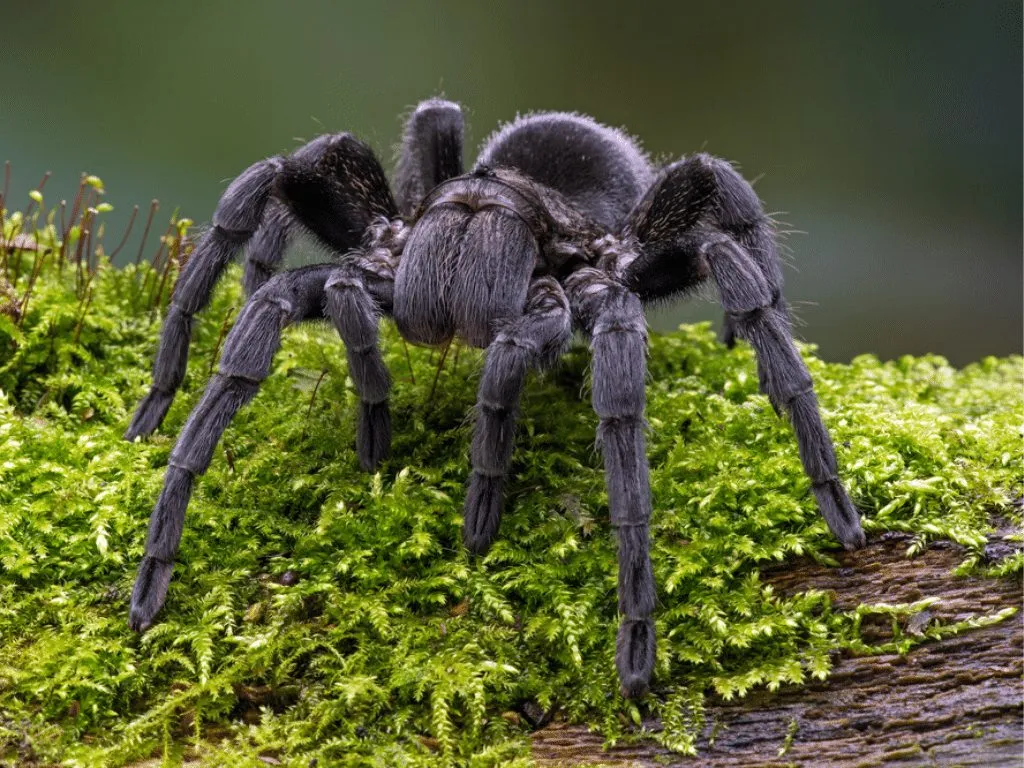What is a Brazilian Black Tarantula?
The Brazilian Black Tarantula (Grammostola pulchra), often simply referred to as the Black Tarantula, is a popular pet spider known for its docile temperament and striking appearance. Native to the grasslands and scrublands of Southern Brazil, these spiders are sought after by arachnid enthusiasts worldwide, including in the UK. Their all-black coloration, combined with their relatively calm nature, makes them a great choice for beginner tarantula keepers. They are also known for their longevity, often living for over 20 years, making them a long-term commitment.
Origin and Habitat
Understanding the natural habitat of the Brazilian Black Tarantula is crucial for providing proper care in a captive environment. These tarantulas originate from the grasslands and scrublands of southern Brazil. In their natural habitat, they are terrestrial spiders, meaning they live primarily on the ground. They typically burrow and create shelters under rocks, logs, or within the soil. The climate in these regions is generally warm and humid, with distinct wet and dry seasons. Replicating these environmental conditions in their enclosure is vital to their health and well-being.
Physical Characteristics
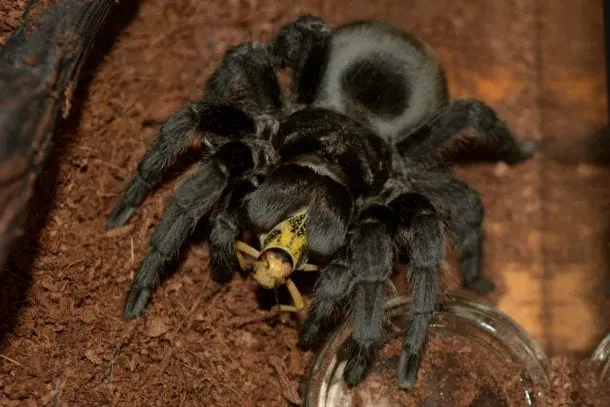
The Brazilian Black Tarantula is instantly recognizable due to its all-black coloration, which is consistent across both males and females. As adults, they can reach a leg span of up to 6-7 inches (15-18 cm), with females generally being larger than males. Their bodies are covered in dense, velvety hairs, giving them a soft appearance. They possess eight legs, two pedipalps (used for manipulating food and sensing their environment), and two chelicerae (fangs) for injecting venom. Their overall appearance is robust and impressive, making them a fascinating species to observe.
Behavior and Temperament
Brazilian Black Tarantulas are known for their docile temperament, making them a good choice for beginners. They are generally slow-moving and less prone to aggression compared to some other tarantula species. However, it’s important to remember that each tarantula has its own personality. Some may be more skittish than others. They are not typically inclined to bite unless provoked, but they may flick urticating hairs (small, irritating hairs) from their abdomen as a defense mechanism. It is essential to observe their behavior closely and handle them with care to avoid stress and ensure their safety.
Caring for Your UK Black Tarantula
Caring for a Brazilian Black Tarantula in the UK involves providing a suitable habitat that mimics its natural environment. This includes appropriate temperature, humidity, substrate, and a balanced diet. Regular maintenance and careful observation are also crucial for ensuring the health and longevity of your tarantula. By following these guidelines, you can create a thriving environment for your pet and enjoy the fascinating world of these incredible creatures.
Choosing the Right Enclosure
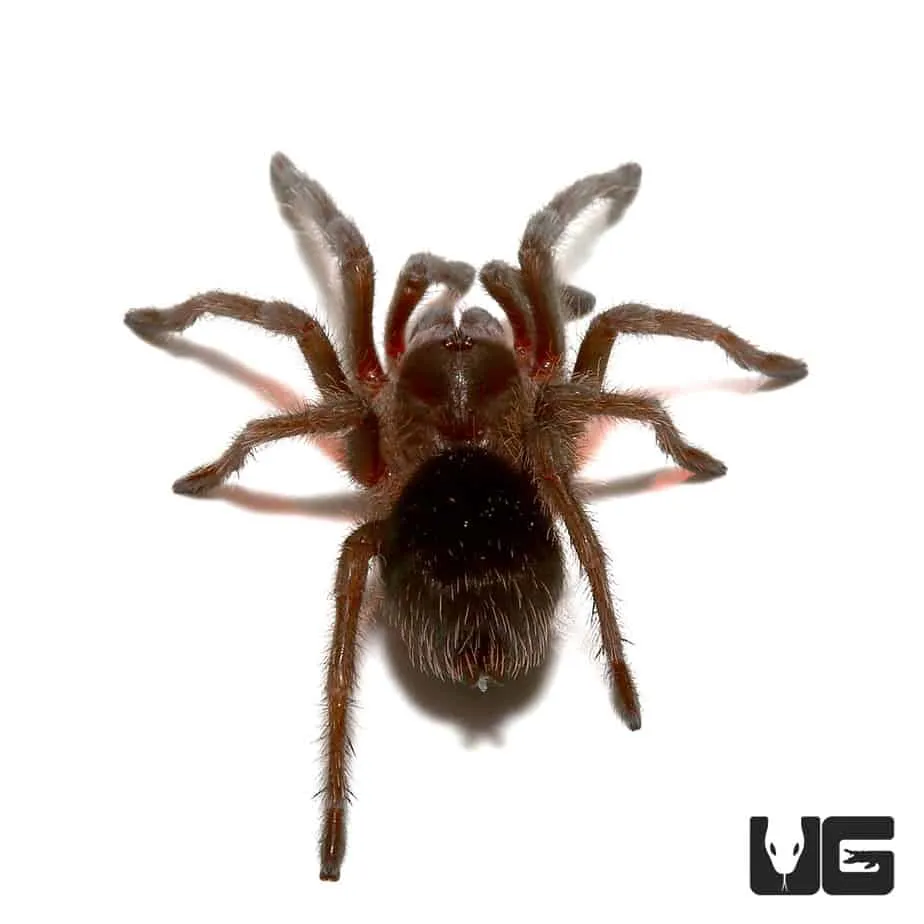
The enclosure is the tarantula’s home, and its size and design are crucial for its well-being. For a Brazilian Black Tarantula, a terrestrial setup is essential. A glass or acrylic terrarium is ideal, as it allows for easy viewing and ventilation. The size of the enclosure should be appropriate for the size of the tarantula; a general rule of thumb is to provide a space that is at least twice the tarantula’s leg span in length and width. Ensure the enclosure has a secure, tight-fitting lid to prevent escape and a suitable ventilation system to maintain air circulation.
Substrate and Habitat Setup
The substrate is the bedding material that covers the floor of the enclosure and provides a comfortable environment for the tarantula. For a Brazilian Black Tarantula, a substrate that retains moisture while allowing for burrowing is ideal. A mixture of peat moss, coconut fiber, and a small amount of vermiculite is an excellent choice. The substrate should be deep enough (4-6 inches) to allow the tarantula to burrow if it chooses. Provide a hide, such as a piece of cork bark or a half log, for the tarantula to feel secure. Add some artificial or live plants (ensure they are non-toxic) to enhance the habitat and provide additional hiding spots. Ensure there is a water dish with shallow water at all times.
Temperature and Humidity
Maintaining the correct temperature and humidity levels is crucial for the health of your Brazilian Black Tarantula. The ideal temperature range is between 75-85°F (24-29°C). You can use a heat mat or a low-wattage heat lamp to provide the necessary warmth. Place the heat source on the side of the enclosure to create a temperature gradient, allowing the tarantula to regulate its body temperature. The humidity level should be maintained between 60-70%. You can monitor humidity with a hygrometer. Mist the enclosure lightly with water every few days or as needed to maintain the appropriate humidity level. Avoid over-misting, as this can lead to mold and fungal growth.
Feeding Your Tarantula
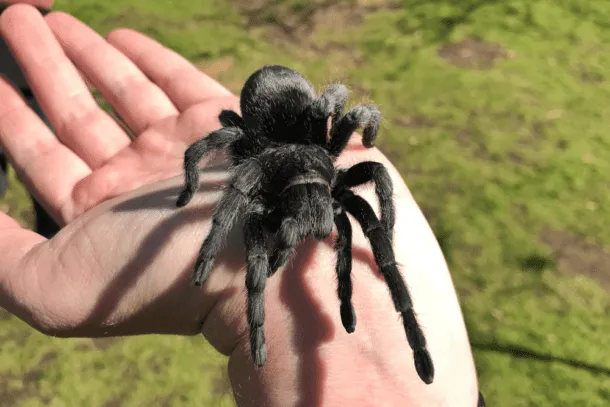
Feeding your Brazilian Black Tarantula is a straightforward process, but it’s important to get it right. They are primarily insectivores, meaning they eat insects. The size of the prey should be appropriate for the size of the tarantula; a good rule of thumb is to feed insects that are no larger than the tarantula’s body. Common food items include crickets, mealworms, and roaches. It is crucial to ensure that the prey insects are gut-loaded (fed nutritious food) before offering them to your tarantula to provide optimal nutrition. Remove any uneaten prey within 24 hours to prevent stress to the tarantula.
Prey Selection and Feeding Schedule
The frequency of feeding depends on the age and size of your tarantula. Spiderlings (young tarantulas) should be fed more often, perhaps every other day. Juveniles can be fed 2-3 times per week, while adults can be fed once a week or every other week. Observe your tarantula’s abdomen; if it appears plump, it has likely eaten enough. Vary the diet to provide a range of nutrients. Avoid feeding wild-caught insects, as they may carry parasites or pesticides. Always provide a shallow water dish with fresh water, ensuring the tarantula always has access to hydration.
Watering and Hydration
Providing fresh water is crucial for your tarantula’s hydration. Always have a shallow water dish with fresh water available in the enclosure. The water dish should be shallow enough to prevent the tarantula from drowning. Check the water dish daily and refill it as needed. Besides the water dish, you can also lightly mist the enclosure with water, particularly during the molting process. This helps maintain the humidity level and provides the tarantula with additional moisture. Be careful not to over-mist, as this can lead to mold growth.
Handling and Safety
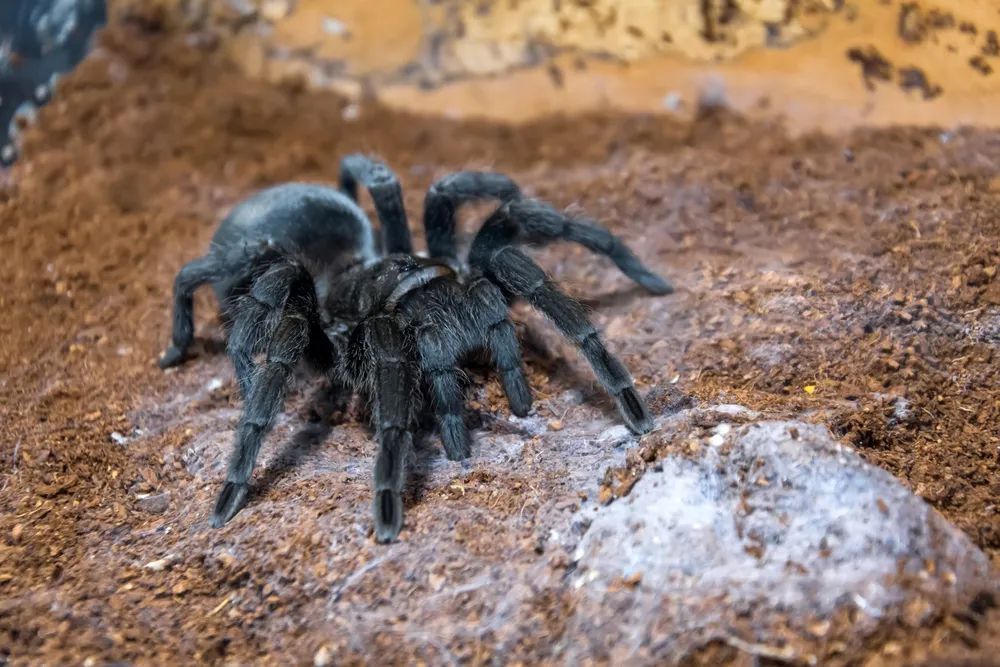
While Brazilian Black Tarantulas are generally docile, handling them should be done with caution and is often best avoided. Tarantulas are fragile, and a fall can be fatal or result in serious injuries. If you must handle your tarantula (for instance, during enclosure maintenance), do so with slow, deliberate movements. Always handle them over a soft surface, like a bed or a carpet, to minimize the risk of injury if they fall. Be prepared for unexpected movement and avoid sudden motions that could startle the tarantula. Washing your hands before and after handling tarantulas is good practice.
Handling Precautions
Before handling, ensure you are calm and relaxed; tarantulas can sense stress. Approach the tarantula slowly. Use a soft paintbrush or a similar tool to gently encourage it to move onto your hand if necessary. Never force the tarantula to move. Avoid placing your hands directly in front of the fangs, which is a natural defensive position. If the tarantula starts to flick hairs, it’s a sign it is stressed, and you should immediately stop handling it. Always supervise children when they are near the tarantula, and educate them on appropriate behavior. Handling should always be kept to a minimum.
Health and Common Issues
Keeping a close eye on your tarantula’s health is vital for its well-being. One of the most crucial aspects of their life cycle is the molting process, during which they shed their exoskeleton and grow. Other common health issues to watch out for include dehydration, mites, and parasitic infections. Recognizing the signs of these issues early can help you address them promptly. A healthy tarantula will have a plump abdomen, move with ease, and eat regularly. A tarantula that refuses food for an extended period, appears lethargic, or exhibits signs of parasites or mites should be examined immediately.
Molting Process
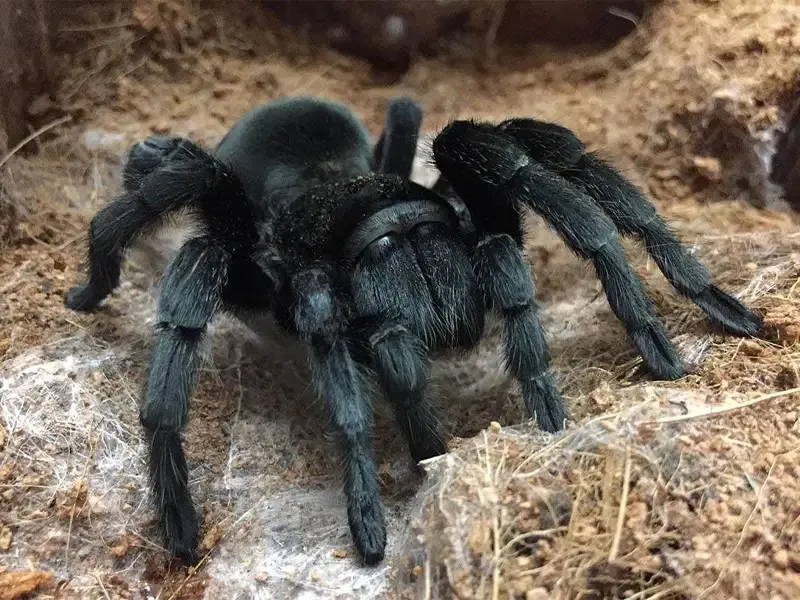
Molting is a natural process in which tarantulas shed their exoskeleton to grow. During this time, the tarantula will typically stop eating, and its abdomen may appear dark and swollen. The tarantula may also flip onto its back. Do not disturb the tarantula during molting. Provide adequate humidity and avoid handling or stressing the tarantula. After molting, the tarantula’s new exoskeleton will be soft and vulnerable; avoid feeding it until it has hardened. The molting frequency decreases as the tarantula ages, with young tarantulas molting more frequently than adults. A successful molt is essential for growth and health.
Common Health Problems
Dehydration can be a serious issue, especially in a dry environment. Ensure your tarantula has constant access to fresh water. Signs of dehydration include a shriveled abdomen and lethargy. Mites are small parasites that can infest tarantulas. They are often visible as tiny, moving spots on the tarantula’s body. Parasitic infections can also affect tarantulas. These are often caused by contaminated food or poor enclosure hygiene. If you suspect your tarantula has a health problem, consult with a veterinarian or a knowledgeable arachnid specialist. Proper care and hygiene can significantly reduce the risk of these issues.
Breeding Brazilian Black Tarantulas
Breeding Brazilian Black Tarantulas can be a rewarding experience but requires significant knowledge and careful planning. It is essential to have a good understanding of tarantula behavior, particularly during the mating process. Only experienced keepers should attempt to breed tarantulas. The process involves several steps, including preparing a breeding enclosure, introducing the male and female, and providing appropriate conditions for mating and egg sac development.
Setting up a Breeding Enclosure
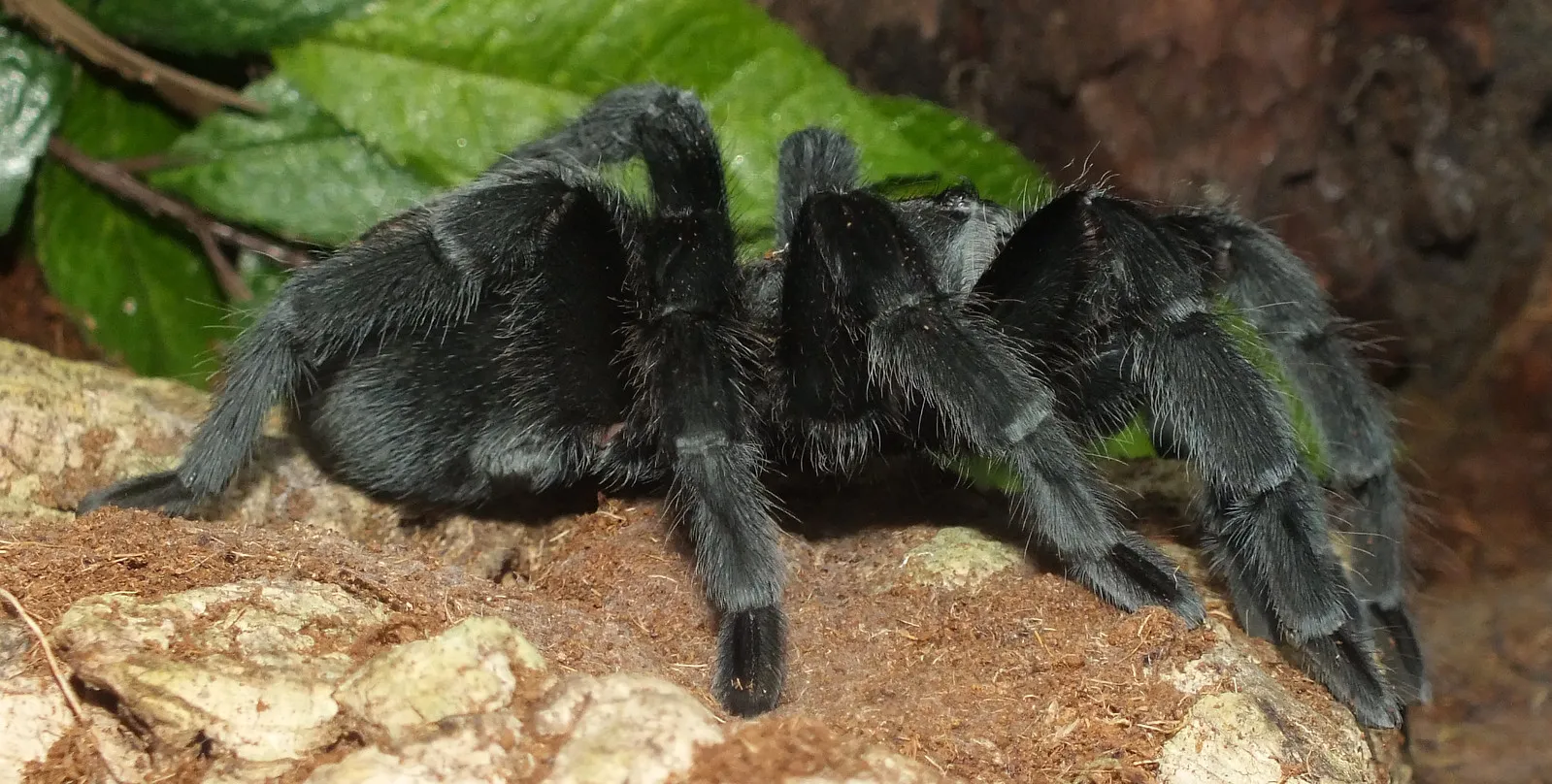
To breed Brazilian Black Tarantulas, you’ll need to prepare a separate breeding enclosure. This enclosure should be similar to the adult enclosure but might have additional features depending on your setup. A larger enclosure provides more space for the mating process. Ensure that the enclosure has appropriate substrate, hides, and a water dish. A controlled environment with optimal temperature and humidity levels is also crucial. Prior to introduction, ensure both the male and female are well-fed and in good health. A calm and stress-free environment is critical for a successful breeding outcome.
Mating and Egg Sacs
Introducing the male and female should be done cautiously, as the female may see the male as prey. Observe their behavior closely. The male will often drum on the substrate to attract the female. If the female is receptive, they will mate. Mating can take place over several hours. After mating, remove the male to prevent him from being eaten by the female. The female will then lay eggs and spin an egg sac. It may take several weeks or months for the egg sac to develop. It is vital to maintain optimal environmental conditions to ensure the successful development of the eggs. The eggs will hatch, and the spiderlings will emerge.
Legality and Ethical Considerations
Before acquiring a Brazilian Black Tarantula in the UK, it’s important to be aware of the relevant laws and ethical considerations. Some countries or regions have specific regulations regarding the ownership of exotic animals, including tarantulas. Additionally, consider the ethical implications of keeping a wild animal in captivity. It is essential to source your tarantula from a reputable breeder who prioritizes the health and welfare of the animals.
UK Laws and Regulations
In the UK, there are no specific laws that prohibit keeping Brazilian Black Tarantulas. However, you must ensure that you are complying with general animal welfare laws, which require you to provide a suitable environment, diet, and care. It is always recommended to research local regulations and guidelines. Also, ensure that you have adequate knowledge and experience before acquiring a tarantula. If you intend to breed your tarantulas, it’s important to be aware of any related regulations.
Ethical Sourcing and Ownership
Always source your tarantula from a reputable breeder or pet store. Ensure that the tarantula is captive-bred, as this supports conservation efforts and avoids the unethical capture of wild animals. Be prepared to provide your tarantula with the best possible care throughout its life. This includes a suitable habitat, a balanced diet, and regular health checks. Consider the long-term commitment involved in keeping a tarantula. Brazilian Black Tarantulas can live for many years. Be prepared to provide consistent care and attention throughout the animal’s lifetime.
